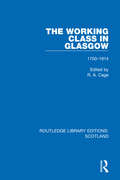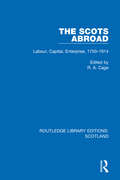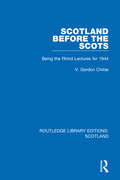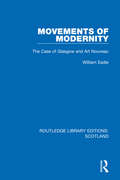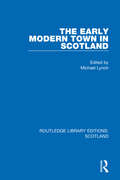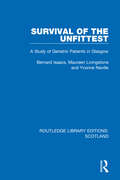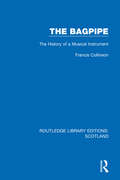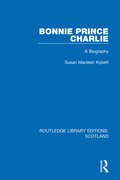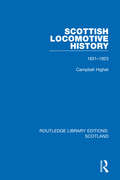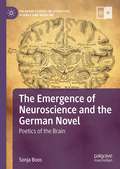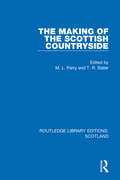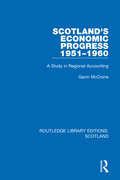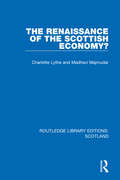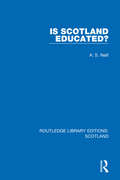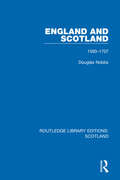- Table View
- List View
The Working Class in Glasgow: 1750-1914 (Routledge Library Editions: Scotland #4)
by R. A CageOriginally published in 1987, this book examines how much industrialisation improved the standard of living of the British worker, based on the experience of one representative city: Glasgow. It analyses whether there was an increase in skilled as opposed to unskilled labour in major industrial centres – as for example in Glasgow, manufacturing shifted from textiles to engineering. Other important issues such as the rate of housing construction, public health, local politics and leisure pursuits are also considered. Glasgow has a long history of working-class culture and is therefore a particularly interesting city to study.
The Scots Abroad: Labour, Capital, Enterprise, 1750-1914 (Routledge Library Editions: Scotland #3)
by R. A. CageOriginally published in 1985, this book examines the extent of Scottish migration and Scottish involvement in the process of development. Although there are many books written on the Scots abroad, this volume is unique in that it has a unifying theme: each contributor has concentrated on the role played by the Scots in the economic development of their relevant country or area which include England, Canada, the USA, Australia, New Zealand, India, Latin America and Japan. This will be of interest to both social and economic historians.
Scotland Before the Scots: Being the Rhind Lectures for 1944 (Routledge Library Editions: Scotland #6)
by V. Gordon ChildeOriginally published in 1946, this book presents in what can arguably be described as an unusual way, a slice of Scottish social life by applying to prehistory the principles of Marxism as practised by Soviet scholars of Russian prehistory. Using archaeological evidence, the author distinguishes 6 stages – from the earliest definable groups of immigrants to the Iron Age. There are 10 appendices, devoted to the typology and classification of tombs, pottery, implements and fortifications.
Movements of Modernity: The Case of Glasgow and Art Nouveau (Routledge Library Editions: Scotland #11)
by William EadieOriginally published in 1990, acknowledges the social as well as the artistic significance of the Glasgow Art Nouveau movement by examining the history of it from its inception through to its demise. By considering the contributions of social theorists like Peter Bürger, Theodor Adorno, and Walter Benjamin, the author illustrates how Art nouveau can be located within an avant-garde. The book also reveals to what extent the contract which the Glasgow group had with the Secessionists in Vienna was significant for the development of their work.
The Early Modern Town in Scotland (Routledge Library Editions: Scotland #16)
by Michael LynchOriginally published in 1987, this volume filled a notable gap in Scottish urban history and considers the place of Scottish towns in urban life during the 16th and 17th Centuries. The first part of the book is based on studies of individual burghs (Aberdeen, Dundee, Edinburgh and Perth) drawing extensively on archival material. The second part includes a discussion of the pressure put upon the burghs by the town between 1500 and 1650, a process which contributed to the destruction of the medieval burgh and examines the burgh during the Scottish Revolution. The impact of war and plague on Scottish towns in the 1640s is also analysed and much emphasis is given to the relationship between town and country.
Survival of the Unfittest: A Study of Geriatric Patients in Glasgow (Routledge Library Editions: Scotland #13)
by Bernard Isaacs Maureen Livingstone Yvonne NevilleOriginally published in 1972, this book is an analytical account of the socio-medical tribulations suffered by Glasgow’s east-end elderly leading to referral to geriatric wards. It examines why so many old people suffer from physical, mental and social deprivation in the final years of their lives. It shows by statistical studies and illustrative case histories that the basic cause is the survival into old age of people who are unfit to care for themselves, in such numbers that help from families, neighbours, the social services and the NHS is insufficient. From this study the expression the "geriatric giants" or the four I’s was coined: impairment of intellect (cerebral dysfunction), incontinence, immobility and instability (falls). The term ‘giant’ is seen to refer both to statistical frequency and to the huge personal burden of sufferers, escalating the need for socio-medical intervention. Prophetic in its predictions that the huge and complex social care problem would grow in the future much of this book remains relevant today.
The Bagpipe: The History of a Musical Instrument (Routledge Library Editions: Scotland #9)
by Francis CollinsonOriginally published in 1975, and written by an authority on Scottish music, this book traces the evolution of the bagpipe whilst also narrating the fortunes of the ‘Great Highland Bagpipe’ itself. Exploring history and archaeology of civilizations as far removed from the Scottish Highlands as Egypt and Mesopotamia, Greece and Rome this book offers a unique full-length history of one of the world’s most interesting and ancient musical instruments. Appendices list the bagpipes of other countries and the materials used in the instrument’s manufacture as well as a comprehensive bibliography.
The Early Modern Town in Scotland (Routledge Library Editions: Scotland #16)
by Michael LynchOriginally published in 1987, this volume filled a notable gap in Scottish urban history and considers the place of Scottish towns in urban life during the 16th and 17th Centuries. The first part of the book is based on studies of individual burghs (Aberdeen, Dundee, Edinburgh and Perth) drawing extensively on archival material. The second part includes a discussion of the pressure put upon the burghs by the town between 1500 and 1650, a process which contributed to the destruction of the medieval burgh and examines the burgh during the Scottish Revolution. The impact of war and plague on Scottish towns in the 1640s is also analysed and much emphasis is given to the relationship between town and country.
Bonnie Prince Charlie: A Biography (Routledge Library Editions: Scotland #14)
by Susan Maclean KybettOriginally published in 1988, this biography was the result of 15 years research, including unearthing 70,000 letters and documents among the Stuart Papers which had hitherto lain largely untapped. Written in many different languages, some were damaged, written in code, or unsigned and undated. Deciphering them therefore made it possible to gain a new level of insight into Bonnie Prince Charlie as a man, his relationship with his exiled father, the role played by France and the true nature of the events leading up to the bloody campaign of 1745 in which he attempted to win back the throne of his ancestors.
Scottish Locomotive History: 1831-1923 (Routledge Library Editions: Scotland #12)
by Campbell HighetOriginally published in 1970, this volume is a valuable source of extensive data concerning Scotland’s railways and locomotives. Material that has appeared in books, technical journals, society and institutional proceedings is here gathered together, enabling the reader to easily trace details of design and construction on the five main railways of Scotland from 1831 until 1923 when all the railways in Britain came together under English control. As well as being of interest to engineers, this volume will also appeal to railway and social historians.
The Bagpipe: The History of a Musical Instrument (Routledge Library Editions: Scotland #9)
by Francis CollinsonOriginally published in 1975, and written by an authority on Scottish music, this book traces the evolution of the bagpipe whilst also narrating the fortunes of the ‘Great Highland Bagpipe’ itself. Exploring history and archaeology of civilizations as far removed from the Scottish Highlands as Egypt and Mesopotamia, Greece and Rome this book offers a unique full-length history of one of the world’s most interesting and ancient musical instruments. Appendices list the bagpipes of other countries and the materials used in the instrument’s manufacture as well as a comprehensive bibliography.
Bonnie Prince Charlie: A Biography (Routledge Library Editions: Scotland #14)
by Susan Maclean KybettOriginally published in 1988, this biography was the result of 15 years research, including unearthing 70,000 letters and documents among the Stuart Papers which had hitherto lain largely untapped. Written in many different languages, some were damaged, written in code, or unsigned and undated. Deciphering them therefore made it possible to gain a new level of insight into Bonnie Prince Charlie as a man, his relationship with his exiled father, the role played by France and the true nature of the events leading up to the bloody campaign of 1745 in which he attempted to win back the throne of his ancestors.
The Emergence of Neuroscience and the German Novel: Poetics of the Brain (Palgrave Studies in Literature, Science and Medicine)
by Sonja BoosThe Emergence of Neuroscience and the German Novel: Poetics of the Brain revises the dominant narrative about the distinctive psychological inwardness and introspective depth of the German novel by reinterpreting the novel’s development from the perspective of the nascent discipline of neuroscience, the emergence of which is coterminous with the rise of the novel form. In particular, it asks how the novel’s formal properties—stylistic, narrative, rhetorical, and figurative—correlate with the formation of a neuroscientific discourse, and how the former may have assisted, disrupted, and/or intensified the medical articulation of neurological concepts. This study poses the question: how does this rapidly evolving field emerge in the context of nineteenth century cultural practices and what were the conditions for its emergence in the German-speaking world specifically? Where did neuroscience begin and how did it broaden in scope? And most crucially, to what degree does it owe its existence to literature?
Movements of Modernity: The Case of Glasgow and Art Nouveau (Routledge Library Editions: Scotland #11)
by William EadieOriginally published in 1990, acknowledges the social as well as the artistic significance of the Glasgow Art Nouveau movement by examining the history of it from its inception through to its demise. By considering the contributions of social theorists like Peter Bürger, Theodor Adorno, and Walter Benjamin, the author illustrates how Art nouveau can be located within an avant-garde. The book also reveals to what extent the contract which the Glasgow group had with the Secessionists in Vienna was significant for the development of their work.
Scottish Locomotive History: 1831-1923 (Routledge Library Editions: Scotland #12)
by Campbell HighetOriginally published in 1970, this volume is a valuable source of extensive data concerning Scotland’s railways and locomotives. Material that has appeared in books, technical journals, society and institutional proceedings is here gathered together, enabling the reader to easily trace details of design and construction on the five main railways of Scotland from 1831 until 1923 when all the railways in Britain came together under English control. As well as being of interest to engineers, this volume will also appeal to railway and social historians.
The Making of the Scottish Countryside (Routledge Library Editions: Scotland #23)
by M. L. Parry T. R. SlaterOriginally published in 1980, this book examines the evolution of the Scottish landscape from pre-historic times to the mid-nineteenth century. It considers the way in which the structural base of agriculture and the changing farming ‘system’ came to alter the Scottish rural landscape. This book, with its focus on the underlying landscape processes, gives a developmental view of landscape change. It therefore considers the crucial question of the rate and pace of landscape change and argues that the Scottish landscape was not the product of a few brief phases of quite rapid development but rather the result of a continual and gradual process of change. It also looks at the regional variation of landscape change and establishes the importance of regional linkages in the diffusion of ideas especially in new technology.
Scotland’s Economic Progress 1951-1960 (Routledge Library Editions: Scotland #20)
by Gavin McCroneOriginally published in 1965, this book subjected the economic performance of Scotland to close examination. The progress of the Scottish economy from 1951 to 1960 was assessed in quantitative terms and estimates provided of Scottish gross domestic product, income from employment, gross profits and other economic statistics. Chapters are devoted to output and investment in manufacturing in industry and to personal income and expenditure. The results showed the extent to which the Scottish economy lagged behind the rest of the UK, especially during the latter part of the decade.
The Making of the Scottish Countryside (Routledge Library Editions: Scotland #23)
by M. L. Parry T. R. SlaterOriginally published in 1980, this book examines the evolution of the Scottish landscape from pre-historic times to the mid-nineteenth century. It considers the way in which the structural base of agriculture and the changing farming ‘system’ came to alter the Scottish rural landscape. This book, with its focus on the underlying landscape processes, gives a developmental view of landscape change. It therefore considers the crucial question of the rate and pace of landscape change and argues that the Scottish landscape was not the product of a few brief phases of quite rapid development but rather the result of a continual and gradual process of change. It also looks at the regional variation of landscape change and establishes the importance of regional linkages in the diffusion of ideas especially in new technology.
The Renaissance of the Scottish Economy? (Routledge Library Editions: Scotland #17)
by Charlotte Lythe Madhavi MajmudarOriginally published in 1982, written at a time when Scotland was emerging from a recession, it offered a comprehensive appraisal of the Scottish economy. The book shows that long-term regional problems had not gone away and that the presence of North Sea oil was not a guarantee of future economic health in Scotland. A major theme of the work is the key role of government expenditure in the (then) recent restructuring of the Scottish economy. Many of the issues discussed remain pertinent today, as Scotland once again discusses the future shape of its economy and political identity.
Is Scotland Educated? (Routledge Library Editions: Scotland #21)
by A. S. NeillOriginally published in 1936, and with more than a slightly tongue-in-cheek tone at times, the author of this book declares that Scotland is not educated but merely learned. This book does not deal with education in its narrowest sense: it ranges from the Kirk to Haggis, Tartans and Burns, Whisky and repressed sex in its discussion, proclaiming Calvinism as the root of most of Scotland’s evils. Honest and at times provocative, this volume does give direct access to the emotional roots of Neill’s feelings about Scottish education.
Scotland’s Economic Progress 1951-1960 (Routledge Library Editions: Scotland #20)
by Gavin McCroneOriginally published in 1965, this book subjected the economic performance of Scotland to close examination. The progress of the Scottish economy from 1951 to 1960 was assessed in quantitative terms and estimates provided of Scottish gross domestic product, income from employment, gross profits and other economic statistics. Chapters are devoted to output and investment in manufacturing in industry and to personal income and expenditure. The results showed the extent to which the Scottish economy lagged behind the rest of the UK, especially during the latter part of the decade.
Is Scotland Educated? (Routledge Library Editions: Scotland #21)
by A. S. NeillOriginally published in 1936, and with more than a slightly tongue-in-cheek tone at times, the author of this book declares that Scotland is not educated but merely learned. This book does not deal with education in its narrowest sense: it ranges from the Kirk to Haggis, Tartans and Burns, Whisky and repressed sex in its discussion, proclaiming Calvinism as the root of most of Scotland’s evils. Honest and at times provocative, this volume does give direct access to the emotional roots of Neill’s feelings about Scottish education.
The Renaissance of the Scottish Economy? (Routledge Library Editions: Scotland #17)
by Charlotte Lythe Madhavi MajmudarOriginally published in 1982, written at a time when Scotland was emerging from a recession, it offered a comprehensive appraisal of the Scottish economy. The book shows that long-term regional problems had not gone away and that the presence of North Sea oil was not a guarantee of future economic health in Scotland. A major theme of the work is the key role of government expenditure in the (then) recent restructuring of the Scottish economy. Many of the issues discussed remain pertinent today, as Scotland once again discusses the future shape of its economy and political identity.
England and Scotland: 1560-1707 (Routledge Library Editions: Scotland #22)
by Douglas NobbsOriginally published in 1952, this book analyses the constitutional, religious, economic and social conditions of the two countries in the late sixteenth century and surveys the complicated history of the following century. The Reformation made possible a transformation of Anglo-Scottish relations. Owing to the difference of institutions, traditions, and ideals, the alternative to absolutism was in the earlier instance the Cromwellian Protectorate and in the later the movement toward national separation arrested only by the contract of the Act of Union. This book charts the history of these relations in the light of divergent national traditions and ideals.
England and Scotland: 1560-1707 (Routledge Library Editions: Scotland #22)
by Douglas NobbsOriginally published in 1952, this book analyses the constitutional, religious, economic and social conditions of the two countries in the late sixteenth century and surveys the complicated history of the following century. The Reformation made possible a transformation of Anglo-Scottish relations. Owing to the difference of institutions, traditions, and ideals, the alternative to absolutism was in the earlier instance the Cromwellian Protectorate and in the later the movement toward national separation arrested only by the contract of the Act of Union. This book charts the history of these relations in the light of divergent national traditions and ideals.
